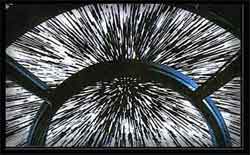For new docs, hefty IOUs tough to shake
Debt-snared med grads must learn to pay now, spend later
By Ryan Bergen
"Suck it up," says finance guru Gail Vaz-Oxlade of Til Debt Do Us Part
Photo credit: Til Debt Do Us Part
Nine out of 10 residents are over $150,000 in debt when they finish their medical training, according to a 2006 survey. "That's not just debt, that's humungous debt," gasps Gail Vaz-Oxlade who's made a career of helping people with their money woes.
Her 20-plus years of experience and firm but folksy style have earned her a weekly television show, Til Debt Do Us Part - think Dr Phil for the financially wayward.
When it comes to climbing out of debt, the promise of a healthy income may be a beacon of hope, but, says Ms Vaz-Oxlade, young docs shouldn't forget the squeeze of being in the hole.
She doesn't waste time with sympathy. Med school, she says, is a choice, and with a "suck it up" — her tough lovin' refrain — at the ready, she lays out the way to mastering debt:
1 Shed student habits
Whether by habit, or a feeling of need, paid residents who are still dipping into their professional students line of credit they need to smarten up, she says. "If you can't live on $50,000 a year without accumlating debt you are going to have a tough time the rest of your life."
2 Chart your debt like a disease
If debt is a problem, then address it like one. Document income, expenses, interest rates. "If you had a patient, and every single day you went in and took that patient's temperature and blood pressure and whatever vital signs you needed and you didn't chart it, no other doctor on this earth's surface would think you were a smart kitten, would they?"
3 Plot your payment course
Create a montly budget - and follow it. It's not sexy, but it helps to keep track of the periodic expenses that can sometimes be forgotten, but must be paid.
4 Give yourself just a little credit
Treat consumer debt like the plague - avoid it. "You don't deserve [a purchase] if you can't pay for it." Credit card balances, usually the most expensive of debts, should be paid off first. More than two credit cards is too many.
5 Don't live on a prayer
Plan for the future, but live in the present. "It's one thing to say 'I am in hock up to my eyeballs to get this education, but I can ammortize that over 15 years.' It is another thing altogether to say that 'while I am a resident making 50,000 frickin' dollars I feel entitled to driving a fabulous car and eating out regularly.' You are still paying your dues, man."
6 Make like a squirrel
Remember to save a little, too. Ms Vaz-Oxlade recommends a minimum of 5% each month. "You have to have an emergency fund…the next time something happens and you have no stash of cash it pushes you back to your credit."
7 Better shop around
Apply the law of supply and demand. "It behooves [young family physicians] to find a community that wants them and negotiate the payment of their student loan as part of their compensation package. There are communities that are willing to do this."
8 Pawn it off on someone else
Consider getting a financial planner. It's their job to know the arcane but clever financial products that can put idle savings to work.

 Nevertheless, I’ve also seen coin jars add significantly to savings. A coworker of mine emptied her jar recently and counted $500 from the past year. This type of savings may not be worthy of your retirement plan, but it can mean the difference between renting an economy car and a convertible on vacation. A mason jar may not support your children’s education, but it might pay for internet service for a year so your kids can research their assignments online. This is significant, and the beauty is in the simplicity.
Nevertheless, I’ve also seen coin jars add significantly to savings. A coworker of mine emptied her jar recently and counted $500 from the past year. This type of savings may not be worthy of your retirement plan, but it can mean the difference between renting an economy car and a convertible on vacation. A mason jar may not support your children’s education, but it might pay for internet service for a year so your kids can research their assignments online. This is significant, and the beauty is in the simplicity. If you’ve been with a bank for 15 years, you feel comfortable with them and are less inclined to feel the need to shop around. This is acceptable behavior as long as you understand that you could be missing out on significant interest income. Take a look at
If you’ve been with a bank for 15 years, you feel comfortable with them and are less inclined to feel the need to shop around. This is acceptable behavior as long as you understand that you could be missing out on significant interest income. Take a look at 
